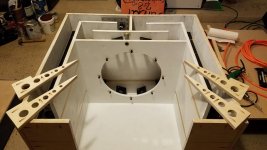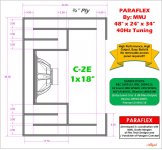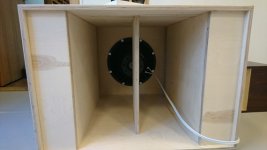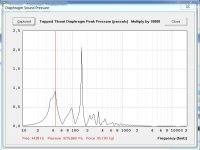I am on some quite powerful pain meds and iv-antibiotics so please excuse me if I come across a bit strange or use the wrong words and terms.
With the ROAR series we wanted to create a loudspeaker that is better at faithfully reproduce the nonlinear acoustic character of music and the highly non-linear and non-sinusoidal content of modern home theater low frequency channel.
The driver couples directly into the large plane wave frontresonator, and we tried to couple the other side of driver as plane and direct as possible via a split path TP section. Compared to the THAM where the driver couples gradually at a 90 degree angle over its total width into both tapps into the resonant expanding pipe section.
There is a lot of benefits with a plane short coupling.
The perceived level of details and the definition of non-linear modulations of the signal is spectacular (imho).
The cone and suspensions are never subjected to warping from an uneven distribution of pressure and a gradual distribution over time as in the THAM series.
The transference of power is much more instant, and partly explains why we never even came close to bottom out a cheap 12 inch car driver when excessively stress tested with a 5 kw amp.
It got hot and we where probably very close to frying the voice coil, but the ROAR prototype testbox held the driver extremely firm and controlled at all times.
With the ROAR series we wanted to create a loudspeaker that is better at faithfully reproduce the nonlinear acoustic character of music and the highly non-linear and non-sinusoidal content of modern home theater low frequency channel.
The driver couples directly into the large plane wave frontresonator, and we tried to couple the other side of driver as plane and direct as possible via a split path TP section. Compared to the THAM where the driver couples gradually at a 90 degree angle over its total width into both tapps into the resonant expanding pipe section.
There is a lot of benefits with a plane short coupling.
The perceived level of details and the definition of non-linear modulations of the signal is spectacular (imho).
The cone and suspensions are never subjected to warping from an uneven distribution of pressure and a gradual distribution over time as in the THAM series.
The transference of power is much more instant, and partly explains why we never even came close to bottom out a cheap 12 inch car driver when excessively stress tested with a 5 kw amp.
It got hot and we where probably very close to frying the voice coil, but the ROAR prototype testbox held the driver extremely firm and controlled at all times.
The extreme opposite of this would be a bass reflex box.
Due to the soft springy character of a mass of air, it takes several cycles to build up the full amplitude respons of the Helmholtz resonator. Leaving several wavelengths of time where the driver is free to move in an less controlled way (risking bottoming out) before the port starts to fully resist and control the motion of the cone.
Transients are not a gradual build up energy and this makes it quite obvious why people prefere midbass horns to bass reflex for a life like reproduction of drums.
Due to the soft springy character of a mass of air, it takes several cycles to build up the full amplitude respons of the Helmholtz resonator. Leaving several wavelengths of time where the driver is free to move in an less controlled way (risking bottoming out) before the port starts to fully resist and control the motion of the cone.
Transients are not a gradual build up energy and this makes it quite obvious why people prefere midbass horns to bass reflex for a life like reproduction of drums.
Circlomanen and others.. i heard Earl Geddes talking about low frequency perception of the ear.
I have been quite off track and i guess most us.
He describes that at high frequencies (4kHz as an example) we detect the signal instantly (milli seconds). But at low frequency below 100 Hz we need a couple of cycles to determine that there is a sound... That is how the ear is made. And if we look at the wavelength at 100 Hz and consider a couple of periods before detection we realise that time alignment, or moving a subwoofer closer or further away doesn´t effect our perseption. Thats why you can have 4 separate subs in each corner of the room and for our ears they will play coherent!
So even if i hate BR i guess it is for other reasons and not for the timing. I hate it because it will pressurice my room and act as a monopole triggering all reverbant nodes in the room, but my dipole bass will not pressurice the room and only trigg one room mode.
So what i want to hear and see is a tapped horn dipole speaker!
Maybe two Roar side by side playing in opposite direction and one of them plays in opposite phase!
Patent?
I have been quite off track and i guess most us.
He describes that at high frequencies (4kHz as an example) we detect the signal instantly (milli seconds). But at low frequency below 100 Hz we need a couple of cycles to determine that there is a sound... That is how the ear is made. And if we look at the wavelength at 100 Hz and consider a couple of periods before detection we realise that time alignment, or moving a subwoofer closer or further away doesn´t effect our perseption. Thats why you can have 4 separate subs in each corner of the room and for our ears they will play coherent!
So even if i hate BR i guess it is for other reasons and not for the timing. I hate it because it will pressurice my room and act as a monopole triggering all reverbant nodes in the room, but my dipole bass will not pressurice the room and only trigg one room mode.
So what i want to hear and see is a tapped horn dipole speaker!
Maybe two Roar side by side playing in opposite direction and one of them plays in opposite phase!
Patent?
Hey there! =)
While posting my new idea of a high tuned series bandpass in another topic there was a reply about the "high order quarterwave society"
-> Log into Facebook | Facebook
with some real interesting designs which reeeeally look like ROAR, just with different located low end entrance into the the big front resonator. Just look at the attached picture below. The guy who built this says the sounding is massive, punchy and tight, how circlomanen already described it.
Greetz from Germany
While posting my new idea of a high tuned series bandpass in another topic there was a reply about the "high order quarterwave society"
-> Log into Facebook | Facebook
with some real interesting designs which reeeeally look like ROAR, just with different located low end entrance into the the big front resonator. Just look at the attached picture below. The guy who built this says the sounding is massive, punchy and tight, how circlomanen already described it.
Greetz from Germany
Attachments
Interesting, thanks Ballfred1, the main difference from the design shown in the picture and ROAR is that in the case of ROAR everything gets boosted by the resonator, the resonator is the final step, while in the designs shown above the resonator mainly (only?) boosts the driver direct output, and this is then coupled with the TP (summation) at the aperture, interesting, I'm not sure right now what that means in terms of performance when compared to ROAR.
@martinsson The above image is an alteration of the Paraflex type-C called the Type-C2A first introduces by Matthew Morgan. It's an evolution of the Super Planar concepts.
Type-C:
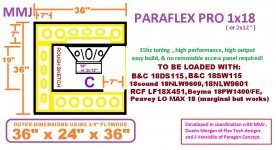
Type-C2A:
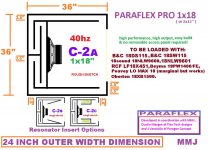
There are many variants explored already including subs and kickbins for both Car sound builds as well as PA builds.
Type-C:

Type-C2A:

There are many variants explored already including subs and kickbins for both Car sound builds as well as PA builds.
Attachments
It's hard to say if Roar/Paraflex outperform the other. There are others in the group that did build a roar and compared and say the paraflex is outperforming the roar. But as far as I know this was not a scientific measurement.
What I do know is that my build and tested Type-C with data comparison with 1m outside ground plane measurement using REW, runs circles around the Xoc1 TH18.
My test included the same driver in both cabinets, the Type-C goes a bit deeper from 30hz up to 130hz and about 5db more output between 60 <> 130hz compared to Xoc1. Of course a bit apple to pears since the Type-C is a bit larger in size.
Here is my measurement of the Type-C:
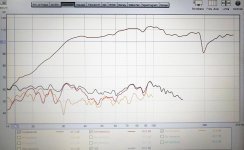
What I do know is that my build and tested Type-C with data comparison with 1m outside ground plane measurement using REW, runs circles around the Xoc1 TH18.
My test included the same driver in both cabinets, the Type-C goes a bit deeper from 30hz up to 130hz and about 5db more output between 60 <> 130hz compared to Xoc1. Of course a bit apple to pears since the Type-C is a bit larger in size.
Here is my measurement of the Type-C:

Cool! that's very impressive, I'll see if I can find out more, I have asked permission to join the group, if they accept me I will try to find out more, I saw there where some really cool renderings on that page, interesting designs, your type-C measurement is really impressive, both in range and response.There are others in the group that did build a roar and compared and say the paraflex is outperforming the roar. But as far as I know this was not a scientific measurement.
Nice Smitske69, I'll keep an eye on the Paraflex topic to follow your progress and findings, I must say the C2A is intriguing, the response shown by USRFobiwan looks amazing! as an 18" design it should be compared with ROAR18 which is roughly 50dm3 bigger than the C2A at 553dm3 external volume.
The measurement (at aperture) of the ROAR seems to indicate it has slightly less distortion, and with a 2nd harmonic dominating the pass band, but if measured in the same fashion we may see other figures.
Do you know where I might find the plans for the C2A? is there a site similar to mine with drawings published?
The measurement (at aperture) of the ROAR seems to indicate it has slightly less distortion, and with a 2nd harmonic dominating the pass band, but if measured in the same fashion we may see other figures.
Do you know where I might find the plans for the C2A? is there a site similar to mine with drawings published?
I visited the diy shoot out in gothenburg in April where matrinsson brought the ROAR15. I've both built and heard a lot of different loaded enclosure types and I got to say that this cab sounded very responsive with a presentation that could sound delicate or powerful depending on the program material. Before listning, I had my doubts due to the ragged simulated frequency responce and group delay. However, when built, it sounds smooth like a high impact band pass sub (in a good way). The lack of higher order distorsion products (due to the suck-out above the band pass) and panel vibration/box-sound is easily noted and very appealing.
Here, there are two pages, my setup is shown sporadically on both.
HiFiForum.nu - DIY & Vintage träff 2019
HiFiForum.nu - DIY & Vintage träff 2019
Hi everyone. Any cutting sheet similar to the THAM15 by any chance ?
>> Martinsson's Blog -
>> Martinsson's Blog -
If you want to assemble it according to the drawings (meaning no cutting away of material, i.e routing groves in the top and bottom panels) then the dimensions of the various pieces making up the enclosure should be pretty easy to derive from the drawings, there should be no dimensions omitted to just that since it is needed for external manufacturing/assembly.
This goes for all the ROAR drawings, a specific cut list was therefore left out, it should not take long to get the dimensions down on paper for all the pieces, there are not that many unique ones (symmetrical design).
This goes for all the ROAR drawings, a specific cut list was therefore left out, it should not take long to get the dimensions down on paper for all the pieces, there are not that many unique ones (symmetrical design).
Hi everyone, Circlomanen brings me here  I have a question regarding the minimum thickness of the PLY as I have weight limitations. Does anybody have tried to build a ROAR15 with 1/4" / 7mm plywood ? would you recommend to do so ? If not, what would be the minimum recommended ?
I have a question regarding the minimum thickness of the PLY as I have weight limitations. Does anybody have tried to build a ROAR15 with 1/4" / 7mm plywood ? would you recommend to do so ? If not, what would be the minimum recommended ?
I'm using a quite powerful driver (the RCF LF15N401) where you can find specs here : https://www.lautsprechershop.de/pdf/rcf/lf15n401.pdf
Thanks ^^
I'm using a quite powerful driver (the RCF LF15N401) where you can find specs here : https://www.lautsprechershop.de/pdf/rcf/lf15n401.pdf
Thanks ^^
Last edited:
You could definitely build a THAM15 from well braced half inch/12 mm birch plywood, but since the ROAR has several parallel and much larger unsupported wall sections I would personally use at least 15 mm birch plywood as an absolute minimum. And use 18 mm or two layer of 15 mm in the baffle holding the driver.
If the cone experiences 85 kg peak force 44,8 times a second at peak output spl, then the rest of the plywood holding the driver and the tapped pipe air column needs to be quite stiff and robust.
If the cone experiences 85 kg peak force 44,8 times a second at peak output spl, then the rest of the plywood holding the driver and the tapped pipe air column needs to be quite stiff and robust.
Attachments
Hi everyone. Any cutting sheet similar to the THAM15 by any chance ?
>> Martinsson's Blog -
Here you go,
considering a 2,6mm blade.
Attachments
- Home
- Loudspeakers
- Subwoofers
- ROAR15
